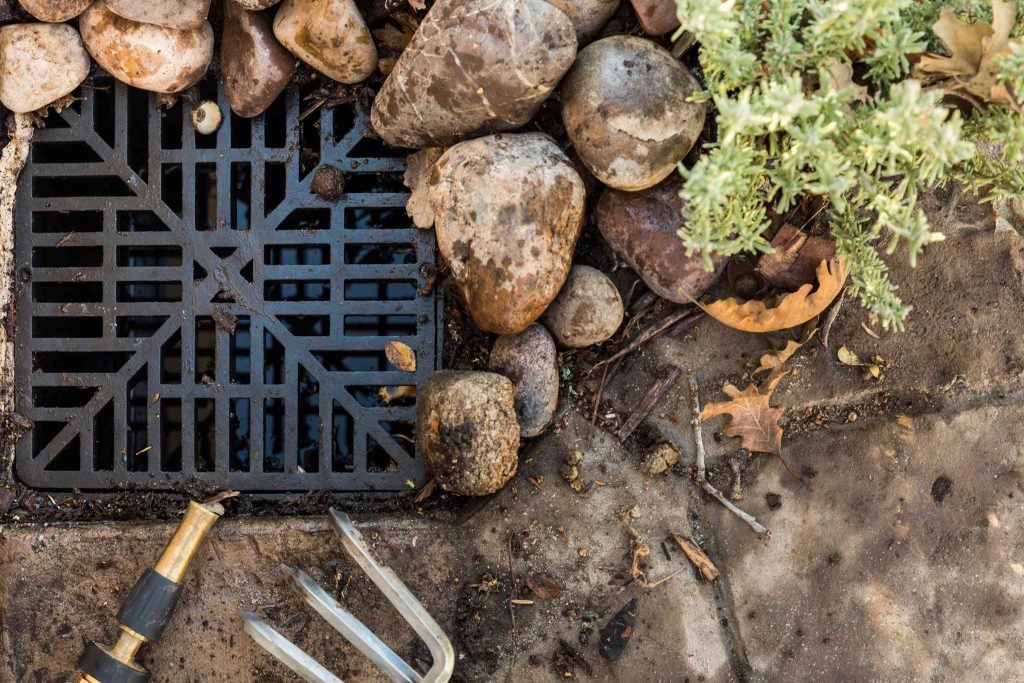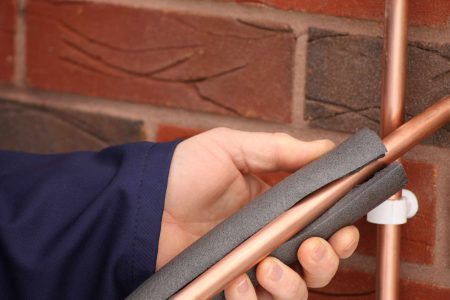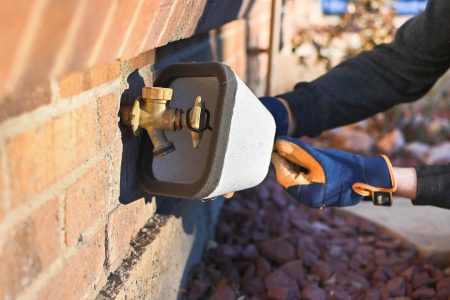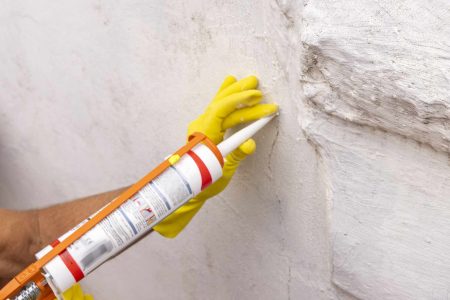A yard drain, also called an area drain or landscape drain, is a common hardscape feature in yards with significant contours, extensive landscaping, or a swimming pool. It can also be used to channel water from a roof gutter and downspout system out into a yard and away from the foundation. This type of drain works much the same way as a floor drain in a garage or basement floor, collecting standing water and channeling it to the street, a storm drain, or other drainage area. You can identify a yard drain by its telltale grate installed at ground level, usually in a low-lying area of the yard. Like any home drain, a yard drain can back up and cause flooding. Proper maintenance of the yard drain will prevent pooling of water in your yard.
How a Yard Drain Works
The structure of a yard drain is very simple: A small underground catch basin covered by a metal or plastic grate catches runoff water, and one or more branch drain pipes carry this collected water from the basin to some termination point—often near a street or into a municipal storm drain. Yard drains can also deliver water to a dry well, retaining area, or surface-drainage field. Piping for yard drains may be corrugated plastic tubing with perforations along the bottom that allow some of the water to drain into the soil along the length of the pipe, or it may be rigid plastic pipe without perforations that carries all of the water to the termination point.
When to Perform Repairs on a Yard Drain
Fall is the key time for servicing a yard drain, as this is when falling leaves are most likely to clog the pipes. If your roof gutters connect to your yard drain, then you must be sure to clean your gutters before clearing the yard drain system.
What You’ll Need
Equipment / Tools
- Screwdriver
- Shop vacuum (optional)
- Hand cultivator
- Garden hose and water supply
- Power auger (if needed)
Materials
- Rubber drain bladder (if needed)
Instructions
Instructions
-
Remove the Drain Grate
Locate each catch basin and remove the drain cover, which is usually a metal or plastic grid set mounted in the rim of the catch basin. Some systems have only one drain grate, while others may have two or more. They are generally located in low-lying areas of the yard but are sometimes located in the center of a large patio or pool deck, or at the spot where roof gutter downspouts empty at the ground near the foundation. Drain grates located in the yard may be obstructed by leaves or yard debris, so you may need to hunt a little to find them.
Sometimes the grates can simply be pried up with a screwdriver; sometimes they are secured to the rim of the catch basin with screws.
-
Clean Out Debris
Clean out as much debris as you can reach by hand by reaching down into the catch basin and into the drain pipes. A hand cultivator can make it easier to scoop up debris. You can also use a shop vac to reach further into the drain pipes to suck out debris.
If the drain branches in multiple directions, make sure to clean out each branch pipe as far as you can reach. Remove anything that does not belong, including rock, dirt, leaves, and trash. Any foreign material in the basin can collect inside the pipes and cause water to back up.
-
Check the Termination Area
Locate the termination area—the point where the drain piping from the basin empties out. This may be near the street curb or somewhere else in your yard where a slope can safely channel water away. Reach in and clean out the termination point as far as you can reach. Some systems may have a grate over the termination point; if so, remove it to reach inside to clean it out. Here, too, a shop vacuum can be used to reach up onto the drainpipe to suck out debris.
If the drain terminates at a dry-well (a subsurface basin usually filled with gravel or large stones), then lift the top of the well and inspect the basin for debris or excess soil. Remove all material that might cause clogging.
-
Flush the Drain Pipes
Flush the drain pipes with water, using a garden hose. Insert the hose as far as possible into the drain pipes from the catch basin, then turn on the water and flush out any remaining debris. You can also use multiple hoses to force even more water through the drain pipes.
Initially, you may see additional debris flushing out at the termination point. At the point where water appears to run free and clear, the drainpipes are free of debris.
-
Reassemble the Grates
With the drain pipes free of debris, reattach the grates over the catch basins and, where applicable, over the termination point. Your drain system is now free of debris, and it should remain in good working order provided the grates are kept clear.
Tips for Dealing With Tough Clogs
If clearing the yard drain by hand and flushing with a hose fails to remove a clog, there are some things to try:
- A rubber drain bladder is a rubber bag that attaches to a garden hose and fits tightly into the drain. When the water is turned on, the bag becomes pressurized to seal the pipe, then shoots water out at pressure to dislodge clogs. This is a helpful technique if the water is stopped up or moving very slowly in the area drain.
- A motorized drain auger is effective at cutting through tough clogs or tree roots. This is the same type of “roto-rooter” plumber’s tool used to clear sewer drains from the house to the city main. Drain augers have a rotating cable with a cutter head that cuts roots and debris from the inside of the pipe. Most yard drains are 3 or 4 inches in diameter (or larger), so make sure to rent a machine suitable for your pipe size (rental augers typically come with 3-inch and 4-inch cutters). You may need to run the auger from multiple directions, including from the termination point back toward the catch basin. If you’re not confident doing this yourself, you can always have a plumber auger the drain.
- Hydro-jetting, or water-jetting, is the use of high-pressure water to clean out a drain line. This works well when there is a significant buildup of dirt, grease, or sludge. While a drain auger can bore right through the stoppage, it doesn’t flush out the debris as efficiently as a hydro-jet. This is a job for a professional plumber.
-
How do you fix poor water drainage in your yard?
Beside a yard drain, there are several other drainage solutions you can add to your yard. For instance, you might opt to regrade the soil to slope it toward a drain. You also can add plants that prefer lots of water. Plus, you can improve dense soil and aerate your lawn so that water drains more quickly.
-
How do you fix a yard that slopes toward the house?
One option is to regrade the soil around the perimeter of the house, so the water flows away from the foundation. A drain system plus downspout extenders also will often be necessary to direct water away from the structure.
-
Is sand or gravel better for drainage?
Small crushed gravel is a better material than sand for improving drainage in a yard. That’s because water can easily flow through the gravel, and the gravel itself doesn’t remain wet. Sand, on the other hand, can become soggy and dense, which can impede water flow.
Read the full article here









